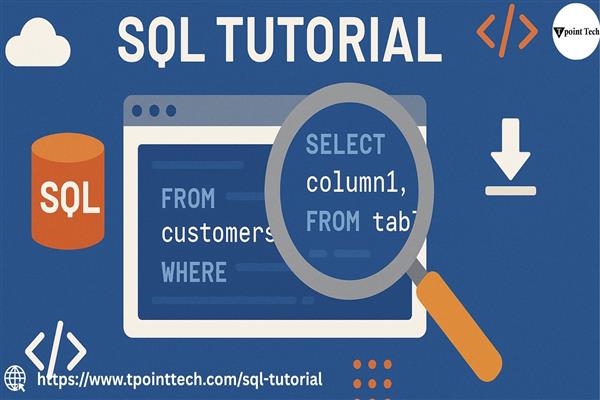Search here

28-May-2025 , Updated on 5/28/2025 3:31:31 AM
SQL Tutorial: A Complete Beginner’s Guide to Databases
In today’s data-driven world, understanding how to manage and access information is an essential skill. Whether you're aspiring to become a software developer, data analyst, or just someone curious about how information is stored and retrieved behind the scenes, learning SQL is a perfect starting point. This SQL tutorial is designed specifically for beginners who want to get a clear, jargon-free understanding of what SQL is and why it’s important.
What is SQL?
SQL stands for Structured Query Language, and it is the standard language used to communicate with relational databases. Think of a relational database as an organized collection of data, much like a digital filing cabinet. Each drawer (or "table") contains information grouped together logically. SQL is the tool you use to open those drawers, find the right folders, read, update, or even delete the information inside.
Why Should You Learn SQL?
In almost every industry—from finance to healthcare to retail—companies rely on data to make informed decisions. SQL is the bridge that connects you to that data. Unlike many programming languages that are used to build applications or websites, SQL is focused purely on data interaction.
Here are just a few reasons to start with an SQL tutorial:
Universality: SQL is used across all major relational database systems.
Simplicity: It’s relatively easy to learn compared to many other programming languages.
Career Value: It’s a must-have skill for many data and tech-related roles.
Powerful Queries: SQL lets you ask very complex questions about your data with just a few lines of instructions.
Understanding the Basics of SQL
Before diving into any advanced SQL tutorial point, it's important to grasp the core concepts that form the foundation of working with databases. Here's what every beginner should know:
1. Databases and Tables
A database is a structured collection of information. Within it, data is stored intables, which are like spreadsheets. Each table contains rows (records) and columns (fields or attributes). For example, a table for a library might have rows for each book and columns for the title, author, and publication year.
2. Data Types
Each column in a table has a specific data type, such as text, number, or date. This ensures that the data is stored consistently and can be validated when entered.
3. Primary Keys
A primary key is a unique identifier for each row in a table. Think of it like a student ID number—it helps ensure that each record can be uniquely recognized.
4. Relationships Between Tables
One of the strengths of relational databases is the ability to link information in different tables. This is usually done throughforeign keys, which refer back to primary keys in another table.
The Role of SQL in Managing Data
SQL allows you to perform various operations on data. Here's a simplified overview of some core capabilities:
Retrieving data: You can ask the database to return specific pieces of information that match certain conditions.
Adding data: You can insert new rows of information into a table.
Updating data: You can modify existing information.
Deleting data: You can remove unwanted or obsolete records.
Sorting and filtering: You can organize the information you retrieve by date, alphabetical order, numerical value, and more.
Each of these tasks forms a core part of any SQL tutorial. As you progress, you'll find yourself combining these operations to build more complex queries and gain deeper insights from your data.
How to Start Your SQL Learning Journey
If you’re ready to learn SQL tutorial material in a way that builds a solid foundation, focus on starting small and practicing often. Use sample datasets like employee records, product inventories, or customer orders to simulate real-world use cases.
Make sure to:
Learn the most common commands and their purposes.
Understand how to filter and sort data efficiently.
Practice with sample tables to reinforce your skills.
Build confidence by trying increasingly complex queries.
Common Mistakes to Avoid
As with any new skill, beginners may fall into some common traps when learning SQL:
Relying on guesswork: It’s tempting to try random commands to see what works, but it’s more effective to understand what each instruction does.
Ignoring data structure: Not knowing how your tables relate to one another can lead to inefficient or incorrect queries.
Skipping fundamentals: Jumping into advanced queries without a strong grasp of the basics can lead to frustration and confusion.
Final Thoughts
SQL is a timeless and powerful tool in the world of data. This SQL tutorial is your first step toward mastering the art of data interaction. Whether you're pursuing a career in tech or simply want to explore how data powers everyday systems, there’s no better place to start than with a foundationalSQL tutorial point.
By taking the time to learn SQL tutorial concepts methodically and thoughtfully, you’ll build a skill that opens doors to countless opportunities across industries. So take that first step today—your journey into the world of databases begins now.

Student
Tpoint Tech offers clear, concise tutorials on the latest technologies, programming languages, and software tools. Perfect for beginners and professionals, our content simplifies complex topics to help you learn faster and grow your tech skills with confidence.
Join Our Newsletter
Subscribe to our newsletter to receive emails about new views posts, releases and updates.
Copyright 2010 - 2025 MindStick Software Pvt. Ltd. All Rights Reserved Privacy Policy | Terms & Conditions | Cookie Policy